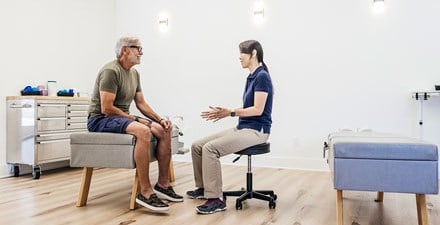
The Centers for Disease Control and Prevention ranks falls as one of the leading causes of fatal and nonfatal injuries among older adults in the United States. Annually, more than 1 in 4 adults over the age of 65 reports falling. Falling once doubles your chance of falling again. One in five falls results in a serious injury, such as broken bones or a head injury.
Although your risk of falling increases with age, falls risk is not limited to older adults. A history of cancer increases your falls risk at any age. This is true whether you are newly diagnosed or receiving end-of-life care. In some studies, 50% to 75% of cancer survivors, many under the age of 65, reported falling at least once during over a six- to18-month period.
Cancer-related falls risk is linked to a cancer diagnosis itself, the side effects of cancer treatment, or both. Cancer-related problems can lead to balance problems and increase falls risk.
Physical therapists help cancer survivors before, during, and after surgery and cancer treatment. They create personalized treatment plans to help people manage cancer-related problems, such as:
- Pain.
- Fatigue.
- Reduced balance.
- Strength.
- Endurance.
Effects of Cancer and Cancer Treatment on Balance
Many factors can contribute to poor balance and an increased falls risk for people with a cancer diagnosis, undergoing treatment, and even after treatment has been completed. They include:
Fatigue and pain. These are the two most common symptoms reported by people with cancer. They often linger even after completing cancer treatment. Body discomfort and general fatigue can be caused by a cancerous tumor. They can also arise from cancer treatments, including surgery, radiation, and chemotherapy.
Weakness. Surgery, radiation, and chemotherapies can cause generalized body weakness or weakness of specific muscles in the shoulders, arms, hips, and legs. Reduced activity levels (inactivity) that often occur during a hospital stay, with increased bed rest or a decrease in activity after returning home, also can lead to weakness.
Vision impairment. Chemotherapies can affect vision, adversely affecting balance and increasing falls risk. A vision problem can make it difficult to see what is in your immediate environment and where your feet are. This can make it difficult to safely move around in your environment.
Vestibular system (inner ear) impairment. Certain chemotherapies, especially those that cause hearing loss, may also damage the vestibular system, which is located in the middle ear and helps you keep your balance.
Neuropathy. Some chemotherapies damage nerves, causing numbness, tingling, or pain in the feet and hands. These symptoms, which are often called chemotherapy-induced peripheral neuropathy, or CIPN, increase falls risk by making walking painful and foot placement uncertain.
Factors for Higher Risk of Falls
As simple as it may sound, having a fear of falling is a sign that you have a higher risk. Here are some other signs to watch for:
- A fall in the previous year. Multiple falls, or a fall with injury, are even more concerning.
- Walking problems such as “slapping” your feet, scuffing your shoes, or dragging your toes increase your risk of tripping.
- Lower body weakness that makes it hard to get up from a chair without using your arms to help.
- Difficulty walking without support from another person, furniture, or a device like a cane or walker.
- Feeling like you are going to fall when you close your eyes or lift one leg (such as when showering or getting dressed).
- Feeling lightheaded or dizzy when you first sit, stand, or when turning your head while walking.
- Needing help with daily activities such as bathing or preparing meals.
- Numbness, tingling, or a feeling of pins and needles in your hands or feet.
- Urinary incontinence (the need to rush to the restroom).
How Can a Physical Therapist Help?
A physical therapist will evaluate your overall health and body function, develop a treatment plan designed to treat your specific symptoms and complications and discuss your treatment goals with you. Using tasks that simulate your daily activities, they will perform a thorough examination to assess your:
- Strength.
- Endurance and flexibility.
- Sensation (ability to feel).
- Vision and inner ear function.
They also will assess your balance and gait (walking).
Your physical therapy treatment plan may include, but will not be limited to:
- Patient education for postural awareness and correction.
- Balance training that includes safe but challenging standing and walking exercises to improve your balance.
- Gait training to improve the safety and quality of your walking.
- Muscular strength training and conditioning (endurance) to help improve your physical function.
- Vestibular rehabilitation activities to challenge and improve your inner ear and brain function.
- Teaching you ways to make your home and community as safe as possible to help you reduce your falls risk. They also may consult with you and provide advice on safe footwear.
Physical therapists are movement experts. They improve quality of life through hands-on care, patient education, and prescribed movement. You can contact a physical therapist directly for an evaluation. To find a physical therapist in your area, visit Find a PT.


